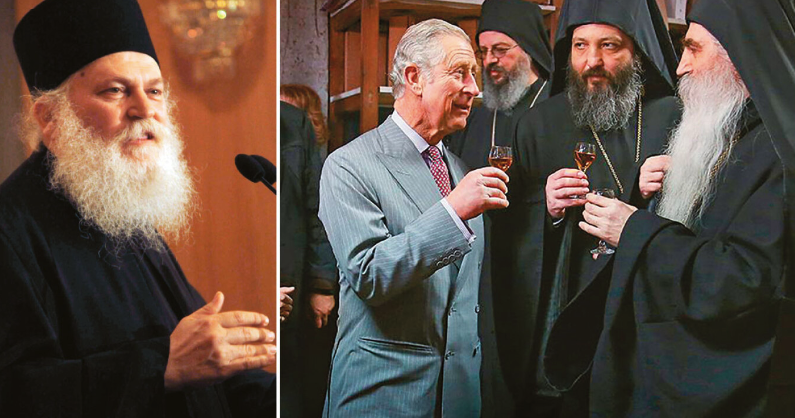It is September 1997. Then-Prince Charles, devastated by the loss of his children’s mother Diana, is looking for a refuge to escape the mass hysteria following the death of his ex-wife.
He finds this peace and solitude in a small cell on Mount Athos. Twenty-seven years later, Charles is king.
He has just announced that he is battling cancer.
He calls on the phone the elder of the Vatopedi Monastery, Ephraim. “Pray for me,” he says.
As with Greece more broadly, Charles has a special relationship with Mount Athos.
According to the British, it is his “spiritual home”.
It’s where he goes to relax.
Or went, to be more precise, since since he has had the title of the Patron Saint of the Faith since he ascended the throne, i.e. he is the official head of the Anglican Church.
This of course does not negate his love for Greece and the Athenian State and fuels various debates.
Donations for restorations
“Monastery Building at Vatopedi”: is the title of the watercolour painting made by the then Prince Charles on Mount Athos in 2000.
He has a hobby – and talent – of painting watercolour paintings, paintings which from time to time are auctioned off to fund the activities of his foundation.
Through one such auction, Charles had funded the restoration work at his beloved monastery, Vatopedi.
And if the church of St. Eudocimus, at the entrance to the Vatopedi Monastery, with its wealth of Byzantine treasures, was restored and consecrated by the British monarch, the most notable example is the Hilandar Monastery, which had been destroyed by fire.
Charles took the initiative to raise money for its restoration, which was the occasion for the founding of the “Friends of Mount Athos” association in London, of which he is of course a member.
He also donated GBP 650,000 for the restoration of the Serbian monastery that burned down in 2003 through his foundation.
In the 30 square metre cell.
In Vatopedi, where he went most often, he lived in ‘his own’ 30 m2 cell like a commoner.
Dressed simply, in his favourite plaid shirts and cloth trousers, Charles, as Prince of Wales, followed the monks’ schedule of waking up before dawn and joining in prayer.
At other times he would, as he said, seek out a path in the lush Mount Athos, wander around the monasteries, discreetly watch visitors, or paint in front of the sea or in his cell.
In the years after 2000 his visits to Mount Athos became more frequent.
No matter how much he tried to keep a low profile, as in all cases it was a purely personal and not an official visit (as the Palace always pointed out) – whether he was disembarking at Karyes from the yacht of a Greek businessman or going directly there – his presence could not go unnoticed.
Besides, he himself was not hiding.
“Charles is secretly Greek Orthodox, like his father,” rumour had it, trying to attribute to him an “incompatibility” with his position as head of the Anglican Church, which was to become as he was heir to the throne.
Let him say, at every opportunity, that he was… drawn to the Greek blood flowing through his veins – the conspiracy theories were rife.
New York: Frame-by-frame the moment robbers empty Gucci store with $50,000 worth of products
According to some others, Charles always had in mind to be remembered in history as the man who corrected the Schism of the Churches, something he himself indirectly fuelled by stating, for example, before Orthodox from Syria that “in times when so few sanctuaries are left, it is literally evil that these symbolic bridges are being destroyed”.
Cancer and tomorrow’s uncertainties
Perhaps not coincidentally, a few days ago, 75-year-old Charles chose to make his first public appearance since it was announced that he had been diagnosed with cancer (his form was not announced) by walking with Camilla to St Mary Magdalene Church at the royal country house in Sandringham, in southern England.
The British monarch will be absent from public duties while he undergoes treatment for cancer, meaning that his public appearances and heavy schedule will be replaced by his first in line to the throne son, Prince William (although the Palace has indicated that any discussion of when William will become king is premature, as there is optimism that Charles will successfully overcome cancer).
Part of his royal duties will also be filled by his wife Camilla, but not universally.
This means that Charles will continue to check government documents from home, while maintaining the Prime Minister’s weekly hearings as normal, with doctors advising him, if necessary, to minimise his interpersonal contacts.




































